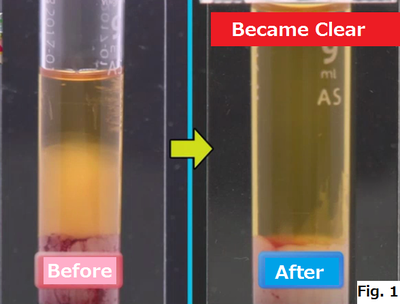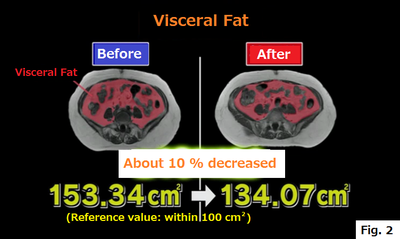|
There are people whose neutral fat and LDL cholesterol are normal but arteriosclerosis is progressed.
When you have a blood test, blood is taken and the blood is centrifugalized. The centrifugalized blood has three parts which are separated to serum and blood cells. If your neutral fat is within the reference value, the serum is yellowish and clear. If it exceeds the reference value, the serum becomes white and cloudy. Postprandial hyperlipidemia When you eat something, fat is absorbed from the small intestines and changes to neutral fat and is delivered to the whole body by the blood. So everybody’s neutral fat after a meal increases to some extent. But as soon as neutral fat starts to increase, a substance decomposing neutral fat called Lipoprotein Lipase (LPL) is secreted. If you are healthy, even if neutral fat increases after a meal, LPL decomposes the neutral fat immediately. So healthy person’s neutral fat doesn’t exceed the reference value even after a meal. But if the function of this enzyme (LPL) becomes weak, the decomposition after a meal can’t catch up with the increase of neutral fat and the measured value exceeds the reference value. Serum which was clear when it was taken before a meal becomes cloudy after a meal. In addition, if you take a next meal before the elevated neutral fat doesn’t go down, the value of neutral fat goes up again and the condition that neutral fat is always high continues all day. Why isn’t it found at the usual medical examination? In the case of the usual medical examination, the blood is sampled without eating anything after dinner of the previous night, so neutral fat value returns to the normal range during sleep. If high neutral fat state continues all day, the wall of the blood vessels is damaged and LDL cholesterol forms plaques, resulting in the progression of arteriosclerosis. What type of people tend to have postprandial hyperlipidemia? People whose weight has gained compared to they used to tend to have postprandial hyperlipidemia. What is the cause of postprandial hyperlipidemia? That is visceral fat. Visceral fat is easily affected by meals and exercises. People who gained weight compared to they used to have high possibility that they have visceral fat. People with a lot of visceral fat tend to have postprandial hyperlipidemia. Why does visceral fat cause postprandial hyperlipidemia? Because it is difficult for people with a lot of visceral fat to decompose neutral fat. Increase of visceral fat makes the function of neutral fat decomposing enzyme lower leading to increase of neutral fat. If your neutral fat is high at the usual medical examination, the one after a meal is much higher. But the progression of arteriosclerosis can be about the same as people who have postprandial hyperlipidemia. How to improve postprandial hyperlipidemia easily 1.Eat water soluble dietary fiber first. Water soluble dietary fiber is rich in sticky food such as natto (fermented soybeans), okra, nameko mushrooms or yamaimo yam and seaweeds such as seaweed laver, kelp, wakame or agar and root vegetables such as daikon radish, calotte or burdock. Water soluble dietary fiber changes to gel after absorbed in the intestines and attaches to the inner wall of the intestines suppressing the absorption of fat that you eat later. In addition to that, water soluble dietary fiber activates Lipoprotein Lipase (LPL) which decomposes neutral fat. So if you eat water soluble fiber first, you can suppress the sudden elevation of neutral fat after a meal. 2.Walking between 30 minutes and 1 hour after a meal for 10 minutes. Fat taken from a meal becomes neutral fat and flows into blood stream between 30 minutes and 1 hour after a meal. If you do aerobic exercise at that time even if it is for 10 minutes, you can suppress the amount of neutral fat effectively. The above two methods improve postprandial hyperlipidemia and prevent the accumulation of neutral fat in the body, leading to decrease of visceral fat. 58 years old female whose neutral fat after a meal was high tried the above two methods for a week. Her blood sample became clear (Fig. 1) and neutral fat 2 hours after eating changed from 164 to 68. The amount of visceral fat decreased by 10 % (Fig. 2).
0 Comments
Leave a Reply. |
IchiroThis Blog is for a memo of my clinical realizations, information about health I have learned recently and update information. Archives
April 2024
Categories
All
|


 RSS Feed
RSS Feed